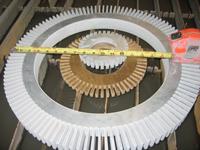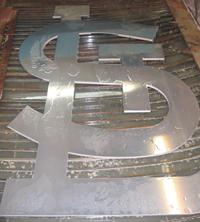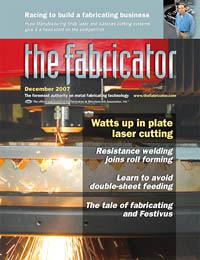- FMA
- The Fabricator
- FABTECH
- Canadian Metalworking
Categories
- Additive Manufacturing
- Aluminum Welding
- Arc Welding
- Assembly and Joining
- Automation and Robotics
- Bending and Forming
- Consumables
- Cutting and Weld Prep
- Electric Vehicles
- En Español
- Finishing
- Hydroforming
- Laser Cutting
- Laser Welding
- Machining
- Manufacturing Software
- Materials Handling
- Metals/Materials
- Oxyfuel Cutting
- Plasma Cutting
- Power Tools
- Punching and Other Holemaking
- Roll Forming
- Safety
- Sawing
- Shearing
- Shop Management
- Testing and Measuring
- Tube and Pipe Fabrication
- Tube and Pipe Production
- Waterjet Cutting
Industry Directory
Webcasts
Podcasts
FAB 40
Advertise
Subscribe
Account Login
Search
Waterjet purchase becomes watershed moment
Equipment addition turns the tide for machine shop's growth
- December 11, 2007
- Article
- Waterjet Cutting
Allright Tool Co. is a woman-owned, family-operated machine shop in Birmingham, Ala. Founded by the Whittingtons in their basement in 1972, the shop began by taking on odd jobs for a large steel company.
Over the next 30 years, the shop grew to be a 22,000-square-foot facility equipped with four CNC vertical mills, two lathes with live turning, two surface grinders, two CNC lathes with manual tool change, and six manual mills. Providing fabricating and welding services to automotive and steel producers, steel tubing mills, and steel pipe finishers worldwide, the shop also performs reverse engineering and CAD for prototyping and developing products in 2-D or 3-D mockups.
In 2004 Allright Tool Co. became the first shop in the Birmingham area to offer abrasive waterjet cutting. This bold move proved to be a wise investment for the business. Within two years of buying its waterjet systems, the company saw its annual revenue increase by more than 79 percent, and it grew from 10 employees to 25, earning it recognition in the Birmingham Business Journal as the eighth-fastest-growing small businesses in the Birmingham area. The publication also named owner Frances Whittington and her husband, Darryl Whittington, as Outstanding Entrepreneurs in 2005.
Shop Manager Chris Lentini attributes the company's recent rapid growth directly to its two Jet Edge waterjet systems.
"Prior to getting the waterjets, we were a run-of-the-mill machine shop, and there were 40 machine shops in the area,"Lentini said. "I knew if we were going to compete and increase our market share, we were going to have to do something different."
With its new systems, Allright Tool Co. has tapped into new markets and has enabled its customers to do the same, he noted.
"The waterjet machines allow both our old and new customers to come up with new avenues of business in markets they dared not try before and to do the diverse machining applications available with waterjets,"Lentini said. "Often we don't know how we got along without them."
For example, Allright Tool Co. actually has won new business from the local stone companies. The job shop now is cutting granite and concrete countertops, marble vanities, and ceramic tile flooring on a regular basis.
The systems also have helped the company increase its productivity by reducing part cutting time from minutes to seconds, and in some cases from hours to minutes, Lentini said. For example, parts that were produced using bolt-down milling fixtures to retain the parts while tooling cut contours on the outside of the part now are done on the waterjet in one-quarter of the time.
With its newfound production speed, Allright Tool Co. also uses the systems both for rapid prototyping finished parts and for prepping parts to be machined.

The electric motor rings and the river dredger part are examples of the large parts that can be cut on the waterjet tables.
"They have made excellent prep machines to reduce secondary machining,"he said. "Concurrently we increase productivity, which increases cash flow, and that is what every business is trying to do."
Choosing a System
In deciding which waterjet system to purchase, Lentini spoke to several customers to get their opinions. Those conversations helped to map out the pros and cons of each system.
Then he focused on the features that would be the best fit for his shop.
"The first thing I liked about the Jet Edge system was the availability of the dual head, because in the same amount of time, you can cut twice the parts,"Lentini explained. "Second was the table size; the competitor did not build the size I wanted. Third was the repeatability and longevity."
Lentini said he favored the high-rail gantry design because it preserves drive components by keeping the ball screws and drives up and out of the way of airborne particulates. In addition, sheet metal enclosures fully protect the mechanical components from the harsh environment created by the waterjet process. A filtered blower on each enclosure introduces a constant positive air pressure that ensures there is no chance of a negative pressure condition in the enclosure system.
Specs and Capabilities
The first waterjet system the company purchased in 2004 is a Jet Edge high-rail gantry system. The 6-ft. by 12-ft. machine is equipped with two abrasivejet cutting heads on a 6-ft. spreader bar and an extra-large 7-ft. by 19-ft. tank, giving it an effective cutting envelope of 72 in. by 216 in. with a 12-in. cut height.
One year later, demand necessitated the purchase of a second machine, a 12-ft. by 8-ft. Jet Edge high-rail gantry with two abrasivejet cutting heads on a 6-ft. spreader bar and 13-ft. by 15-ft. tank, which gives it an effective cutting envelope of 168 in. by 144 in. and a 12-in. cut height.
This second machine was built extra-long so lengthy parts can be cut in one pass. Its work area can accommodate and process two full 6-ft. by 12-ft. sheets simultaneously, making it an extremely efficient configuration for the job shop environment.
Both machines are powered by a 55,000-PSI, 100-HP Jet Edge 55-100B intensifier pump.
Lentini explained that he equipped the machines with oversized tanks so he could cut larger parts. In addition, the high-rail gantry design will allow him to expand the machines in place as business grows.

Of course, with waterjet cutting technology, a shop can cut more than metal. Allright cut an intricate vinyl flooring inlay for McAdory High School in McCalla, Ala., the alma mater of multisport athlete Bo Jackson. The project required 500 separate programs, eight hours of programming, and three days of cutting.
"You can always cut small parts on a large machine, but you can't cut large parts on a small machine,"he said.
With the waterjets the company cuts a variety of materials, including AR 500 plate, T-1 plate, chromium carbide overlay plate, glass, rubber, titanium, stainless steel, brass, aluminum, copper, wood, granite, marble, porcelain, concrete, and ceramic bricks.
The company cuts 12-in.-thick tool steel on a regular basis, achieving high cut quality. One part being cut regularly requires a 14-in.-long, 3-in.-wide slot to be cut through 12-in.-thick tool steel. On the waterjet machine, the part is completed in three hours. On a mill, the part would be completed in about 12 hours and require two setups because the part's thickness would require that it be flipped over halfway through the machining process. In addition, the machining process would require the use of expensive carbide tooling bits.
Additional Projects
The waterjet systems also have enabled Allright Tool Co. to take on numerous projects that would have been impossible by any other method, Lentini added. One such project requires the company to cut 5⁄8-in. titanium that has been fused with carbon fiber.
"You have to use a waterjet to get the desired cut, or you would fray or melt the carbon fiber,"he said. "There is no other way to do this."
Lentini said the waterjet cuts the parts so precisely, the customer no longer samples them for accuracy.
"Of 300 parts they tested, all were within ± 0.001-inch repeatability and ± 0.002-inch machined surface,"he said.
Allright Tool Co. has completed a number of high-profile projects with its waterjet systems, including cutting 20, 12-ft. by 16-ft. logos for Busch Stadium in St. Louis. The extra-large waterjet tank was instrumental for the project because it allowed Lentini to place 12-ft. sheets of 1⁄4-in. aluminum on the table and cut them in one pass, a feat that would have been impossible with a smaller tank.
Lentini also is very proud of a decorative motorcycle part his company cut for bike designer Greg Dotson of Nightstalkers Inc. (a.k.a. The Bike Barn). Dotson's custom chopper took Best in Show at the 2006 O'Reilly World of Wheels competition in Birmingham.
Related Companies
subscribe now

The Fabricator is North America's leading magazine for the metal forming and fabricating industry. The magazine delivers the news, technical articles, and case histories that enable fabricators to do their jobs more efficiently. The Fabricator has served the industry since 1970.
start your free subscription- Stay connected from anywhere

Easily access valuable industry resources now with full access to the digital edition of The Fabricator.

Easily access valuable industry resources now with full access to the digital edition of The Welder.

Easily access valuable industry resources now with full access to the digital edition of The Tube and Pipe Journal.
- Podcasting
- Podcast:
- The Fabricator Podcast
- Published:
- 04/16/2024
- Running Time:
- 63:29
In this episode of The Fabricator Podcast, Caleb Chamberlain, co-founder and CEO of OSH Cut, discusses his company’s...
- Trending Articles
AI, machine learning, and the future of metal fabrication

Employee ownership: The best way to ensure engagement

Dynamic Metal blossoms with each passing year

Steel industry reacts to Nucor’s new weekly published HRC price

Metal fabrication management: A guide for new supervisors

- Industry Events
16th Annual Safety Conference
- April 30 - May 1, 2024
- Elgin,
Pipe and Tube Conference
- May 21 - 22, 2024
- Omaha, NE
World-Class Roll Forming Workshop
- June 5 - 6, 2024
- Louisville, KY
Advanced Laser Application Workshop
- June 25 - 27, 2024
- Novi, MI




























